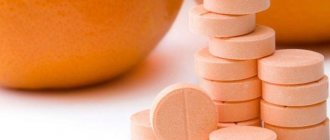Why do we need vitamin A?
Vitamin A has two forms. Retinol is a ready-made vitamin A found in foods of animal origin. And the carotenoid is provitamin A (first derived from carrots). When ingested, it is converted into vitamin A. Carotenoids enter the body with vegetables, seasonings and fruits.
Retinol is involved in the redox processes of the human body. Helps heal inflammation and wounds on the skin - for example, psoriasis or eczema. Develops local immunity through the mucous membranes of the mouth and nose. Participates in the formation of sex hormones, and during pregnancy is responsible for ensuring that the embryo receives nutrition.
Doctors recommend vitamin A for the treatment of many diseases: bronchitis, dysentery, psoriasis, diseases of the eyeball, rickets, mastopathy, liver cirrhosis, leukemia and many others.
Vitamin A (Retinol)
General characteristics of vitamin A (Retinol)
Vitamin A (Retinol) was discovered in 1920 by a group of scientists, it is the first vitamin discovered.
Scientists, after much research, came to the conclusion that butter and the yolk of a chicken egg contain a substance associated with lipoids necessary for the growth of animals; they also showed that butter contains an active principle that is not destroyed by the action of alkalis and remains outside during saponification saponified fraction. This substance was designated "fat soluble factor A" and was later renamed vitamin A.
Other names for vitamin A are Anti-infective vitamin, anti-xerophthalmic vitamin, retinol, dehydroretinol.
There are two forms of this vitamin: ready-made vitamin A (retinol) and provitamin A (carotene), which is converted into vitamin A in the human body, so it can be considered a plant form of vitamin A.
It has a pale yellow color that is formed from the red plant pigment beta-carotene. During heat treatment, it almost does not lose its properties (only 15-30%), but in combination with air during long-term storage it is destroyed.
Physicochemical properties of vitamin A
The vitamin A group includes the following compounds: Retinol, Retinal, Retinoic acid, Retinol palmitate, Retinol acetate.
Vitamin A is a cyclic unsaturated alcohol, which, when oxidized in the body, forms vitamin A-aldehyde and retinoic acid.
Food Sources of Vitamin A
Foods rich in vitamin A - carrots, pumpkin, bell peppers, spinach, broccoli, green onions, parsley, peaches, apricots, apples, grapes, watermelon, melon - are plant sources (carotenoids); Animal sources include fish oil and liver (especially beef), followed by butter, egg yolks, cream and whole milk.
Cereal products and skim milk, even with vitamin supplements, are unsatisfactory sources, as is beef, which contains negligible amounts of vitamin A.
Daily requirement for vitamin A
The recommended daily dose of vitamin A is:
- Infants: 0-6 months. – 400 mcg; 7-12 months – 500 mcg
- Children: 1-3 years – 300 mcg; 4-8 years – 400 mcg
- Men: 9-13 years old – 600 mcg; 900 mcg (3000 IU) for 14-70 years
- Women: 9-13 years – 600 mcg; 700 mcg (2300 IU) for 14-70 years
- Pregnant women: under 19 years old – 750 mcg; 19-50 years old – 770 mcg
- Women breastfeeding: under 19 years old – 1200 mcg; 19-50 years old – 1300 mcg
For diseases associated with retinol deficiency, the dosage can be increased to 10,000 IU per day (calorizer). (The above dosages apply exclusively to the retinoid form of vitamin A. The carotenoid form is not as toxic).
Retinol can be obtained from pharmaceutical supplements (which is 1/3 of the daily requirement), and 2/3 of this vitamin can be obtained from natural foods that contain carotene, such as sweet peppers or carrots.
Beneficial properties of vitamin A
Vitamin A (retinol) is a fat-soluble vitamin, an antioxidant, essential for vision and bones, as well as healthy skin, hair and immune system function. Retinol is involved in redox processes, regulation of protein synthesis, promotes normal metabolism, the function of cellular and subcellular membranes, plays an important role in the formation of bones and teeth, as well as fat deposits; necessary for the growth of new cells, slows down the aging process.
Vitamin A fights viruses and bacteria well, helps strengthen nails and speed up wound healing.
It has a good effect on the reproductive system of men and women, increases the activity of the production of sex hormones.
Harmful properties of vitamin A
Vitamin A can be harmful if overdosed. When there is an excess of it, the body is poisoned and manifests itself in the following symptoms: loss of appetite, nausea, headache, inflammation of the cornea, enlarged liver (calorizator).
Pregnant women should use this vitamin with caution, because An excess of Retinol can lead to developmental disorders of the fetus and the appearance of various congenital pathologies in the child.
Vitamin A absorption
Vitamin A is fat-soluble, so it requires fats as well as minerals to be absorbed by the digestive tract.
Its reserves remain in the body long enough that it does not need to be replenished every day.
Vitamin A deficiency in the body
With a deficiency of vitamin A, night blindness develops, a skin rash appears, the skin peels off, premature aging begins, increased susceptibility to various diseases, visual acuity decreases, dry eyes occur, conjunctivitis develops, dandruff and hair loss appear, and appetite decreases.
Excess vitamin A in the body
With an excess of vitamin A, the following symptoms appear: nausea, vomiting, drowsiness, headache, lethargy, redness of the face, pain in the bones of the lower extremities, menstrual irregularities.
Participation in the vision process of vitamin A
Carotenoids (ie, plant sources of vitamin A) are the main sources of protection for our eyes, they help prevent cataracts, and also reduce the risk of macular degeneration, which is the main cause of blindness.
Participation in the body's antioxidant defense of vitamin A
Vitamin A is an essential component of the body's antioxidant defenses, especially carotenoids. It promotes its interaction with free radicals, including oxygen free radicals - this is the most important feature of the vitamin, which allows it to be considered an effective antioxidant.
The antioxidant effect of vitamin A plays an important role in the prevention of heart and artery diseases, also has a protective effect in patients with angina pectoris, and also increases the content of good cholesterol in the blood (calorie).
Due to the fact that Retinol is considered a powerful antioxidant, it is a means of preventing and treating cancer, and prevents the reappearance of tumors after surgery.
Interaction of vitamin A (Retinol) with other substances
Vitamin A significantly enhances the antioxidant properties of vitamin E, but it can be destroyed completely if there is not enough vitamin E in the body. Also, Retinol is not retained in the body if there is not enough vitamin B4.
Vitamin E (tocopherol) protects vitamin A from oxidation both in the intestines and in tissues. Therefore, if you are deficient in vitamin E, you cannot absorb the required amount of vitamin A and therefore the two vitamins must be taken together.
Zinc deficiency can impair the conversion of vitamin A into its active form. Because the body, in the absence of sufficient zinc, cannot synthesize vitamin A-binding protein—the transport molecule that transports vitamin A through the intestinal wall and releases it into the blood—zinc deficiency can result in poor supply of vitamin A to tissues. These two components are interdependent: thus, vitamin A promotes the absorption of zinc, and zinc also acts in relation to vitamin A.
Mineral oil, which can sometimes be taken as a laxative, can dissolve fat-soluble substances (such as vitamin A and beta-carotene). These vitamins then pass through the intestines without being absorbed because they are dissolved in mineral oil, from which the body cannot extract them. Chronic use of mineral oil can thus lead to vitamin A deficiency.
For normal absorption of Retinol, the presence of fats and proteins in the diet is necessary. The difference between edible oil and mineral oil is that the body can absorb edible fat along with the vitamin A dissolved in it; The body does not absorb mineral oil.
For more information about vitamin A, watch the video “Great Vitamin A. A Brick in the Building of Health”
Author: Marina L. (especially for) Copying this article in whole or in part is prohibited.
Discuss on the forum
Daily value of vitamin A
The dosage of retinol depends on the age and gender of the person. So, adult men need 650-950 mcg of vitamin A. Women need a little less - 600-800 mcg. For pregnant women, the daily requirement increases by 100 mcg, and for nursing mothers - by 410 mcg of this vitamin.
The children's norm varies between 400-1000 mcg. If there is a shortage, the dosage is increased to 3000 mcg.
Vitamin A is best absorbed with fatty foods. Remember: when cooking, foods fortified with vitamin A lose up to 40% of retinol.
Vitamin A deficiency
The main symptom of vitamin A deficiency is the appearance of “night blindness”. When the eyes take a long time to adjust when the lighting changes. It's time to sound the alarm if, when moving from a brightly lit room to a dark one, your eyes take more than 30 seconds to adapt.
A lack of vitamin A is indicated by tearing and burning of the eyes in the winter sun or in bright light. And also dry “goose bumps” on the elbows and thighs. It is also worth taking a course of vitamin A if you have dry mouth, nose, or throat.
Where is vitamin E found?
So, what foods contain vitamin E? This must be known in order to prevent a lack of the substance in the body and its excess (both conditions are very dangerous for humans). Many products contain too little of it, and many, on the contrary, contain incredibly high concentrations.
Vitamin E is found in large quantities in foods that contain a lot of vegetable fat:
- wheat germ oil;
- cottonseed oil;
- corn oil;
- sunflower oil;
- linseed oil;
- hazelnut kernels;
- almond;
- Walnut;
- peanut;
- peas;
- buckwheat grain;
- cabbage;
- bakery products;
- greenery;
- various types of fish;
- fruits and vegetables;
- meat.
The least amount of tocopherol is found in vegetables, fruits, meat and fish.
The oil contains the most vitamin E, but you shouldn’t expect a miracle from the oils that people buy in the store. Only natural products will contain tocopherol in the required quantity. The daily norm of the substance is easily replenished if you consume about 25 grams of products per day that contain tocopherol in large quantities. Therefore, it is very useful to eat sunflower and pumpkin seeds. Coconut and palm oils are very rich in vitamin E, but eating them is not recommended due to the enormous harm to humans. But they are often used in cosmetology for the skin of the face and body. But there is practically no tocopherol in fish oil.
There is absolutely no vitamin E in dried, salted and smoked meat. However, even when prepared in a different way, it contains almost no this substance.
Tocopherol is also found in negligible quantities in all dairy products. Moreover, the longer the product is stored, the less of this substance it contains.
There is an opinion that vegetables and fruits can replenish the daily requirement of vitamins when consumed daily. It is advisable to choose products that do not need to be thermally processed, since high temperatures reduce the amount of vitamin.
There is much more tocopherol in flour products and cereals. But it can be preserved, and in small quantities, only in whole grain bread. Other products are processed too much, thereby losing their beneficial properties.
Signs of vitamin E deficiency
If the reserves of tocopherol in the body are negligible or absent altogether, then the following diseases may occur:
- cancer;
- heart and vascular diseases;
- decreased skin regenerative ability;
- amyotrophy;
- decrease in hemoglobin;
- lack of sexual desire;
- problems with the reproductive system;
- sudden weight gain, obesity;
- decreased immunity;
- decreased skin elasticity;
- the appearance of senile pigmentation on the skin due to the destruction of adipose tissue.
As soon as a person notices at least one of the listed conditions, he needs to be examined as soon as possible and begin treatment and take a vitamin complex while simultaneously reviewing his diet. This is especially important for young girls and women planning pregnancy. The first signs of vitamin E deficiency include the following:
- deterioration of the condition of nails and hair, the appearance of fragility;
- the appearance of wrinkles;
- exacerbation of skin diseases such as eczema or dermatitis (in cases where they appeared previously);
- rapid mood swings;
- indifference to everything and fatigue;
- bad mood.
If a girl wants to lose weight, then she should avoid diets in which she cannot eat fatty foods at all. This can cause serious problems with the body.
Why is vitamin E useful for women?
During pregnancy, it is imperative to provide the body with the required amount of tocopherols. If a woman does not think about whether she is taking enough vitamin E, the pregnancy may simply be terminated, ending in a miscarriage or pathology in the development of the fetus. It is enough to introduce into the diet foods that contain a lot of vitamin E. In case of acute deficiency of the substance, the doctor may prescribe additional medications with tocopherol.
If enough vitamin E is taken when planning pregnancy and while expecting a baby, the child will be protected from allergies to pollen and animal dander. It is this vitamin that stimulates lactation and will help prevent the formation of stretch marks if you start rubbing vitamin E cream into the skin in advance during the growth of the abdomen during pregnancy and after.
Folic acid and vitamin E, as well as omega fats, are important for a woman throughout pregnancy. They will help to avoid many problems and pathologies of the fetus.
For men, the vitamin is no less important, since it also affects male reproductive function. Men even require more vitamin E per day than women.
Cosmetic effect of vitamin E
Tocopherol is also very useful for the face. It can be found among the ingredients in any cream or mask with a rejuvenating effect. It can be effectively used to slow down age-related skin changes. With regular use:
- prevents rapid skin aging;
- wrinkles are smoothed out;
- the skin becomes more elastic;
- wounds and other skin lesions heal faster;
- the skin stops peeling, the lipid balance is normalized;
- along with it, retinol is well absorbed, which helps the skin renew itself.
A positive and quick effect can be achieved if you simultaneously take tocopherol both externally and internally (in capsules). You can even add it yourself to face masks and creams, but they act only superficially - only on the upper layers of the epidermis.
Excess vitamin A
With long-term use, the vitamin accumulates in the liver. Then it becomes toxic to the body. Vomiting, dizziness, diarrhea, and yellow discoloration of the skin may occur.
Pregnant women should especially carefully monitor the dosage of retinol. If it is in excess, fetal development is disrupted. And the baby may be born with a congenital defect of the skull or bones.
What the doctor said
– Vitamin A is responsible for the growth of the body, for its development. That's why it's so useful for children. It also affects the normal condition of the skin and mucous membranes. With a lack of vitamin A, all kinds of viruses cling faster - the same flu, ARVI. Therefore, any bacteria first gets on the mucous membrane, and if it is not properly protected, then the virus enters further into the body.
This vitamin also regulates twilight and color vision. It is also called the “vitamin of beauty and youth” because it is responsible for skin renewal.
It is better to get vitamin A through its natural sources - plant and animal foods, because in artificial form it does not work well. And even when at one time it was a very popular opinion that beta-carotene prevents lung cancer, it turned out that in smokers, on the contrary, it can cause lung cancer. Also, pregnant women should not consume a lot of vitamin A. In case of an overdose (when using synthetic drugs), there is a risk of fetal deformation, said nutritionist Elena Solomatina, Candidate of Medical Sciences .









